Hole in the Clouds
Sep 25, 2009
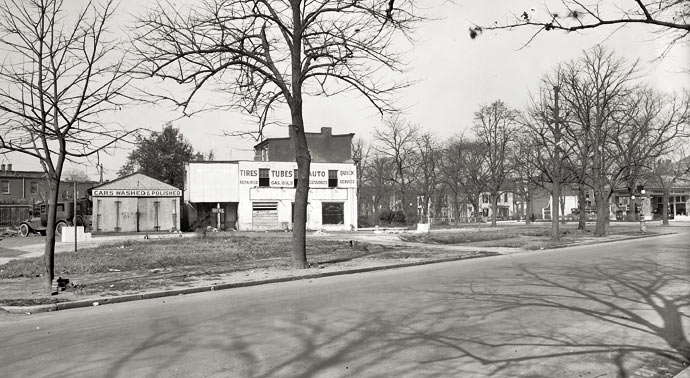
I'm sure there are more than two stories that can be linked to this street corner in Washington, D.C., but I see two in the photo.
The first one is a tale of two gas stations: The year is 1925, cars have only been on the road for a few years, but already here we see a derelict gas station, rundown, boarded up, the gas pump already removed. The parked car may or may not be a junker, but it's not much of an advertisement for the carwash service. But look across the street, at the far right edge of the picture. You may want to enlarge the photo to see full detail. (Or ask me to send you the very high-resolution original photo, 2.6 MB file.) That's a brand spanking new Standard Oil Co. gas station, the original category killer--so Story #1 is about how Mr. Rockefeller probably put this guy out of business and blighted this corner of my hometown.
Story #2 is about the corner itself. It's 2nd Street and Massachusetts Avenue NW, which is stunning to those of us who feel they know Washington. Mass Ave is one of the businest streets in the city, and the intersection is in the heart of downtown, about four blocks from Union Station. In 1925, there wasn't even a line painted down the middle of Mass Ave. Furthermore, based on the trees and their shadows, we can deduce that the picture was taken in late afternoon or early evening--rush hour. Perhaps it was Sunday, but still--the wide-open emptiness is not consistent with our notions of a major downtown artery. This scene feels like a small town, or the edge of a city, not the center of the nation's capital, just eight blocks from the U.S. Capitol building.
What's there today? Nothing. Grass and a couple of curving walkways--I think the local term is pocket park. It's an unusual park, however, built on the air rights above the I-395 freeway as it dives underground just north of Massachusetts Avenue. Rumor has it that behind this park, they're planning to build offices and even stores and apartments, all on the I-395 air rights. This is said to be the biggest construction project in Washington right now that hasn't been suspended--maybe it hasn't been suspended, but it's not yet what they call shovel-ready.
And for what it's worth, the Standard Oil station isn't there any more either; that corner is occupied by a medium-sized brick office building that serves as Washington headquarters for a business association.
vintage
Washington, DC
cityscape
Standard Oil
cars
(Image credit: Nat'l Photo Co., via Shorpy)
Jan 21, 2011
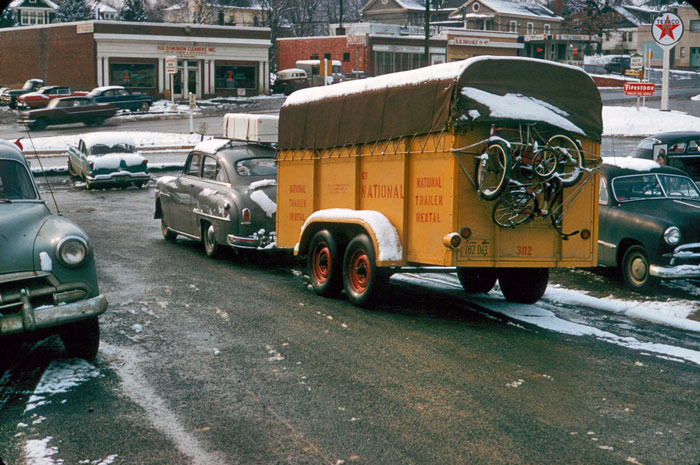 The car was packed, the trailer was hitched, and in late December 1956 this family set off to begin a new life in West Palm Beach, Florida, with three little kids in the backseat and another on the way. The photo was taken just before they left home, on Lee Highway in Arlington, Virginia.
The car was packed, the trailer was hitched, and in late December 1956 this family set off to begin a new life in West Palm Beach, Florida, with three little kids in the backseat and another on the way. The photo was taken just before they left home, on Lee Highway in Arlington, Virginia.
This is a perfect picture.
I don't know the family, and I don't remember ever visiting Arlington in the 1950s, but I was living about ten miles away back then in Maryland, and this is exactly what the world looked like. My immediate neighborhood was a quiet little subdivision, but once we got in the car and went to the grocery store or anywhere else we went, this is what I saw--these same cars, that Texaco sign, those commercial buildings, the plate glass windows at the dry cleaners. This was how the world looked . . . from where I sat in the backseat.
I see now that none of the cars had outside rear view mirrors. But that wasn't too important because back before carseats and seatbelts, a driver could ask the kids in the backseat to get up on their knees and look out the back window and see if it was clear. Unless you were hauling a trailer, of course.
cars
streetscape
baby boom
moving
1956
(Image credit: JohnZ14 via Shorpy)
Apr 25, 2011
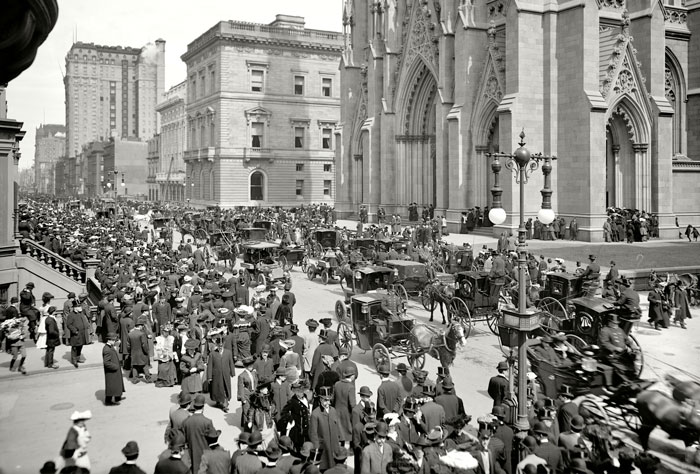 This was the scene on Fifth Avenue in New York City during the 1904 Easter Parade.
This was the scene on Fifth Avenue in New York City during the 1904 Easter Parade.
Easter Parades are different from all other parades: no floats, no marching bands. They began spontaneously in the 1870s, according to what I read on the intertubes, as people got dressed up in their finest and went downtown to promenade. Easter parades still existed in Washington when I was a little girl, I believe along Connecticut Avenue. I never actually saw one in person, but I did get new clothes, new white gloves, and sometimes even a new hat with a ribbon.
If you click on this picture and study the enlarged version, there are plenty of details for your delectation: a horseless carriage amidst the horsey kind, a boy delivering flowers, men with tophats amongst the men with bowler hats. . . .
cars
streetscape
spring
New York City
horses
parade
Fifth Avenue
Easter
(Image credit: Detroit Publishing Co., via Shorpy)
Jun 22, 2012
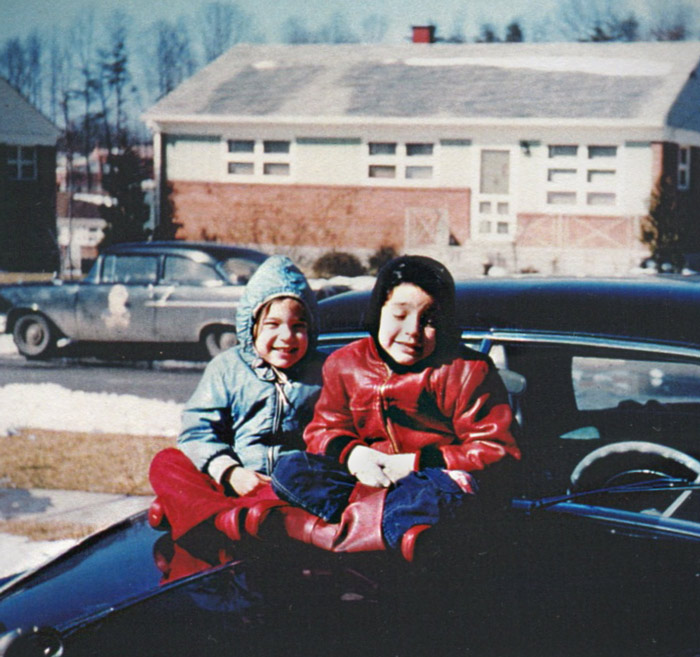 In the winter of 1957, my little sister Carol and I posed for a picture on the hood of my grandfather's Chevy, in the driveway next to our house in Silver Spring, Maryland. The house in the background across the street was identical to ours and to all the others in the neighborhood.
In the winter of 1957, my little sister Carol and I posed for a picture on the hood of my grandfather's Chevy, in the driveway next to our house in Silver Spring, Maryland. The house in the background across the street was identical to ours and to all the others in the neighborhood.
Neighborhoods like ours were called GI tracts back then, new subdivisions built for the baby-booming families of World War II veterans, who bought the houses with no down payment and bargain-rate VA mortgages. Every house was soon overflowing with kids; seven children grew up in that house across the street, and the houses on either side of ours both held six children. We never ran out of kids to play with.
A brand new school was built for us; it opened the year before I started kindergarten and was overcrowded from day one. But it was only a few short years, maybe fifteen or twenty, before the demographic bulge had moved on and MacDonald Knolls Elementary School actually closed down for lack of kids. The school building is now privately owned, used for office space with a small daycare center in one former classroom.
The neighborhood in general has morphed from GI tract to what I guess would be designated an ethnic community; most of the families living there now are Vietnamese, as are the businesses in nearby shopping centers.
I took the picture below of our old house about five years ago. It's a leafy, tree-shaded kind of place now, which was definitely not the case back in the day, though neighbors had put out small trees, supported by guy wires that we used to trip over. The house itself looks well-kept and largely unchanged, except for new windows and siding and a fancy new storm door.
Perhaps the most significant change is in the driveway: there are two cars there now, which is perfectly normal in 21st-century America, but back in the 1950s each family had only a single car. On Monday mornings, after the fathers drove off to work, the neighborhood was pretty much empty of cars and we kids had the streets to ourselves.
The second car is necessary because middle-class life now requires a second wage-earner. I read recently that since the Great Recession more and more households are needing a third wage-earner to make ends meet; new household formation in this country is almost at a standstill.
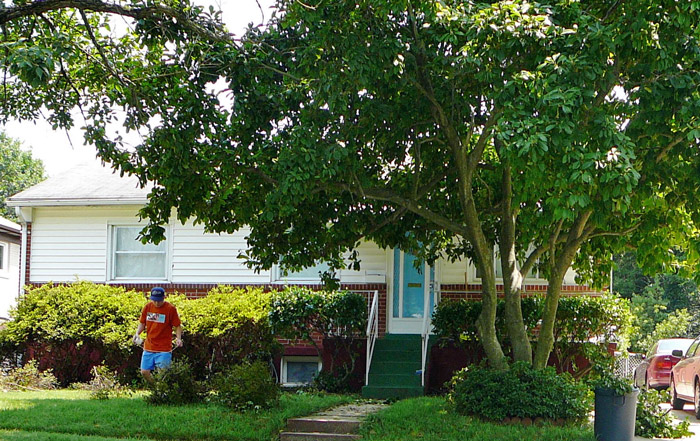
kids
cars
Maryland
streetscape
1950s
winter
Ellen
Carol
houses
Benson Terrace
Silver Spring
boots
Nov 2, 2012
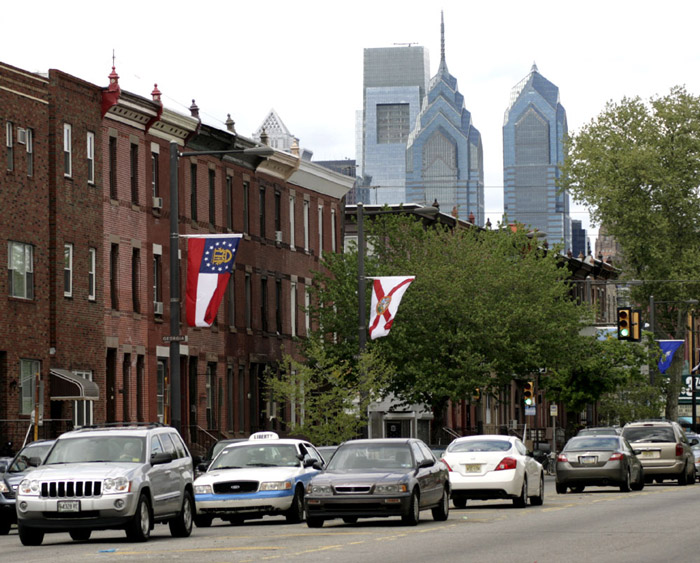 Odd thing about Broad Street in South Philadelphia: people park in the middle of the street.
Odd thing about Broad Street in South Philadelphia: people park in the middle of the street.
Between the northbound and southbound lanes, there is pavement marked with diagonal yellow stripes, the kind of striping that, in all other parts of the world, says to drivers: "Keep your car out of this area." But on Broad Street, at least on the part of Broad Street that runs through South Philly, the empty space between lanes calls out, "Hey, right over here–park your car! Right here in the middle of the street."
Facing north, facing south, doesn't matter. Free parking is free parking.
cars
streetscape
skyline
South Philly
Broad Street
parking
local knowledge
(Image credit: Steve Ives)
Mar 23, 2013
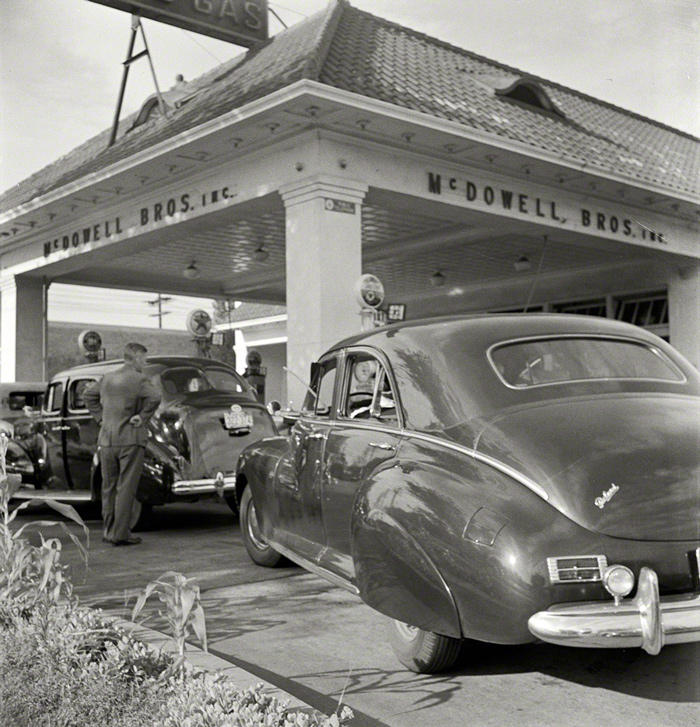 By 7 a.m. on June 21, 1942, the line of cars at this Texaco station, and at pretty much every gas station in America, spilled out of the lot and on down the street. Strict gas rationing to conserve fuel for the war effort was set to begin the next day, June 22, 1942.
By 7 a.m. on June 21, 1942, the line of cars at this Texaco station, and at pretty much every gas station in America, spilled out of the lot and on down the street. Strict gas rationing to conserve fuel for the war effort was set to begin the next day, June 22, 1942.
Note the corn plants growing in the grassy spot in the lower left corner of the picture. Note also the car closest to the camera: a brand new 1942 Packard.
McDowell's Texaco was in the 5200 block of Wisconsin Avenue NW, near Friendship Heights at the edge of Washington, D.C; a parking garage now occupies the spot.
Washington
cityscape
cars
World War II
District of Columbia
1942
5252 Wisconsin Ave NW
(Image credit: Marjory Collins for Office of War Information)
Jul 24, 2014
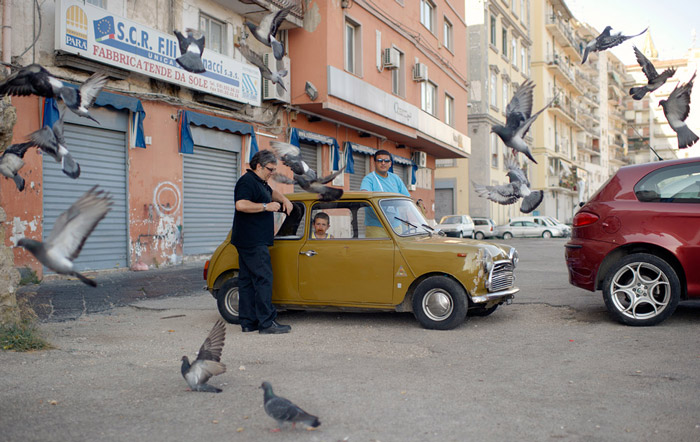
cars
streetscape
Italy
pigeons
Naples
(Image credit: Helgesen)
Feb 4, 2016
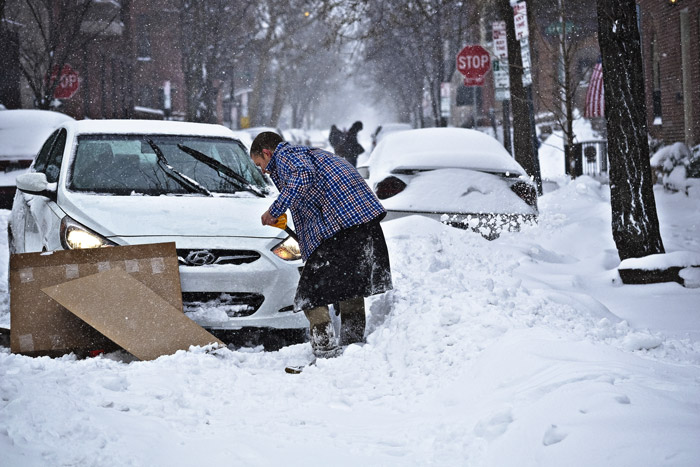 Ten or so days ago, when Philly got whacked by a pretty good thump of snow, this guy was the only one out driving around in the neighborhood, until he wasn't.
Ten or so days ago, when Philly got whacked by a pretty good thump of snow, this guy was the only one out driving around in the neighborhood, until he wasn't.
He was going the wrong way up 24th Street–and really, why not? There were no other cars on the road. But he slipped and slid, and then he was digging and digging. . . .
One of the neighbors brought him some cardboard, which was eventually helpful, but nobody offered to help him shovel, which might have made a more immediate contribution. (In our own defense, it is noted here that ever since last August, when we moved into an apartment, we no longer own a snow shovel.)
It's warmed up now and rained, and the snow is disappearing. Maybe this next month will bring us more winter, but maybe not.
cars
winter
snow
neighborhood
Philly
24th Street
(Image credit: Fuji T)
Jan 22, 2017
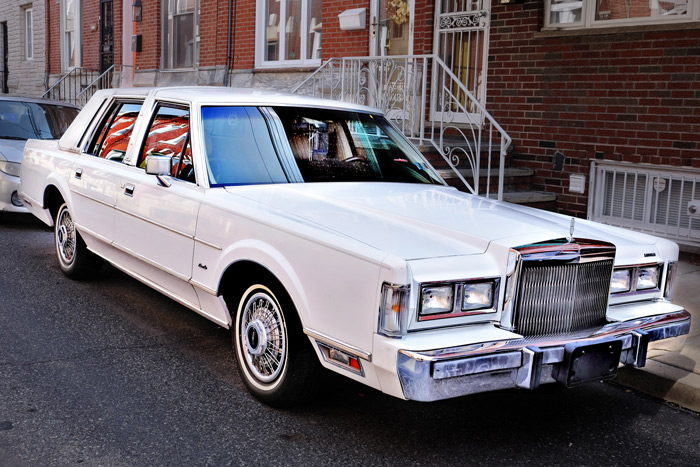 Last spring, when we first came across this scene on a block of Hicks Street in deep South Philly, we just naturally assumed that the white car was a Cadillac. Took us till now to realize that no, maybe it should be a Cadillac, but in real life it's a Lincoln Continental. Some of us are just not as observant as we need to be.
Last spring, when we first came across this scene on a block of Hicks Street in deep South Philly, we just naturally assumed that the white car was a Cadillac. Took us till now to realize that no, maybe it should be a Cadillac, but in real life it's a Lincoln Continental. Some of us are just not as observant as we need to be.
What we can say, however, based on observations of our own lyin eyes as well as gossip, is that this Lincoln is regularly washed but never driven.
cars
streetscape
South Philly
parking
(h/t: C Duffy)
Hicks Street
Lincoln
(Image credit: Fuji T)
Apr 4, 2018
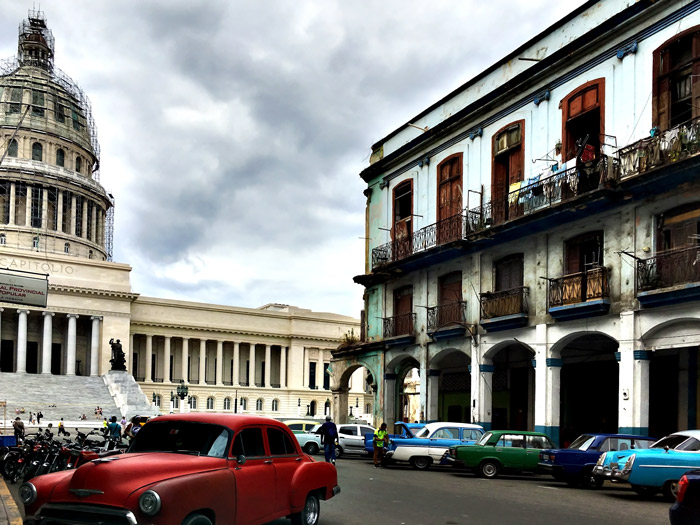 About two weeks after this photo was taken, the Cuban national capitol building reopened following an eight-year renovation project.
About two weeks after this photo was taken, the Cuban national capitol building reopened following an eight-year renovation project.
The building, completed in 1929–during an era when Cuban dictators were, let's say, sucking up to the American governmen–is an exact replica of the U.S. Capitol and was used for the national congress. After the revolution, Castro repurposed it as an office building, most recently for the Ministry of Science and Technology.
El Capitolio will return to its original use April 12, when the Cuban national assembly convenes in the building to choose a new president. For the first time since the revolution, nobody named Castro will be in the running.
cars
streetscape
Havana
Cuba
balconies
capitol building
(Image credit: the phone)



 In the winter of 1957, my little sister Carol and I posed for a picture on the hood of my grandfather's Chevy, in the driveway next to our house in Silver Spring, Maryland. The house in the background across the street was identical to ours and to all the others in the neighborhood.
In the winter of 1957, my little sister Carol and I posed for a picture on the hood of my grandfather's Chevy, in the driveway next to our house in Silver Spring, Maryland. The house in the background across the street was identical to ours and to all the others in the neighborhood.





